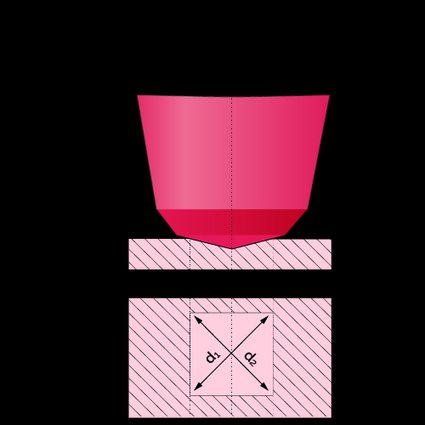Vickers Hardness Number Calculator
This Vickers hardness number calculator uses the size of indentation to return the hardness of the material. There are different scales to measure hardness, including Brinell hardness, Rockwell hardness, Meyers hardness, and Vickers hardness test.
The Vickers hardness scale, named after the company where it was developed in 1921, is the focus of this article. This test is an alternative to Brinell hardness, and it is relatively easier to use because it does not depend on the cone diameter or size of the indenter. The article also briefly covers how to perform the Vickers hardness test.
Read on to understand how to calculate the Vickers hardness number once you have completed the indentation experiment.
Vickers hardness test
Hardness tests measure the resistance of a material against plastic deformation. To perform these tests (be it Brinell, Rockwell, or Vickers), an indenter is pressed on the surface of the specimen with a specific force for a time interval of, say, 10-15 s. During this interval, the material undergoes plastic deformation, which you will measure after unloading the material specimen.
The indentation could be of different shapes depending on the type of test. For a Vickers hardness test, you'll use a diamond indenter with angle , and it would leave a square pyramid shaped indentation. The diagonals of the indentation are measured and averaged. Once you know the mean diagonal, you can use the Vickers hardness calculation number formula to find its value.
ISO 6507
You can find the test conditions, guidelines, and formula for calculating the Vickers hardness number in the international standard document – BS EN ISO 6507-1: Metallic materials — Vickers hardness test.
Vickers hardness number
The Vickers hardness number, , is a function of normal force in kgf (kilogram-force), , mean diagonal in mm, , and, surface area of the indentation. Mathematically, Vickers hardness number in is given by:
where:
- – Acceleration due to gravity, ; and
- – Angle of indenter, commonly taken as .
In order to convert the Vickers hardness number to , you have to multiply the value by the gravitational acceleration . Such that, hardness in is:
The above parameter is also known as surface area hardness.
Tensile strength
You can also estimate the tensile strength from the hardness number by dividing it with a constant . Such that:
The constant depends on several factors; however, as a rule of thumb, is taken as for metallic crystalline materials.
Using the Vickers hardness number calculator
Let's calculate the Vickers hardness number for a material specimen having an indentation with a mean diagonal of under a load of .
To calculate Vickers hardness number:
- Enter the load value, .
- Fill in the value of mean diagonal as, .
- Using the Vickers hardness calculation formula:
- The calculator also returns the surface area hardness, and tensile strength as , and , respectively.
Nomenclature of Vickers hardness number
The Vickers hardness number is written as or , where:
- – Hardness number;
- – Load value (in kgf); and
- – Loading time.
FAQs
How do I calculate Vickers hardness number?
To calculate Vickers hardness number:
- Divide the angle of indenter by
2. - Multiply force by the sine of the resultant.
- Divide the product by gravitational acceleration.
- Divide the quotient by square of the mean diagonal.
- Multiply the result by
2to obtain the Vickers hardness number.
What is the Vickers hardness calculation formula?
The following equation gives the Vickers hardness formula: HV = 2 × F × sin(α/2) / (g × d²) for a given loading force F and indenter with angle, α, leaving an indentation with a mean diagonal, d, on the material specimen.
What is the Vickers hardness number for iron?
The Vickers hardness number for iron is 30-80HV5. This implies that if the test is conducted under a load value of 5 kgf, the Vickers hardness number would be 30 to 80 kgf/mm². This value is just an estimate, and the actual value depends on the composition of the iron specimen.
What is the HV value for carbon steel?
The Vickers hardness number for carbon steel is 55-120HV5. If the test is conducted under a load value of 5 kgf, the Vickers hardness number would be in the range of 55 to 120 kgf/mm². As an estimate, the value may vary depending on the composition of carbon steel.
